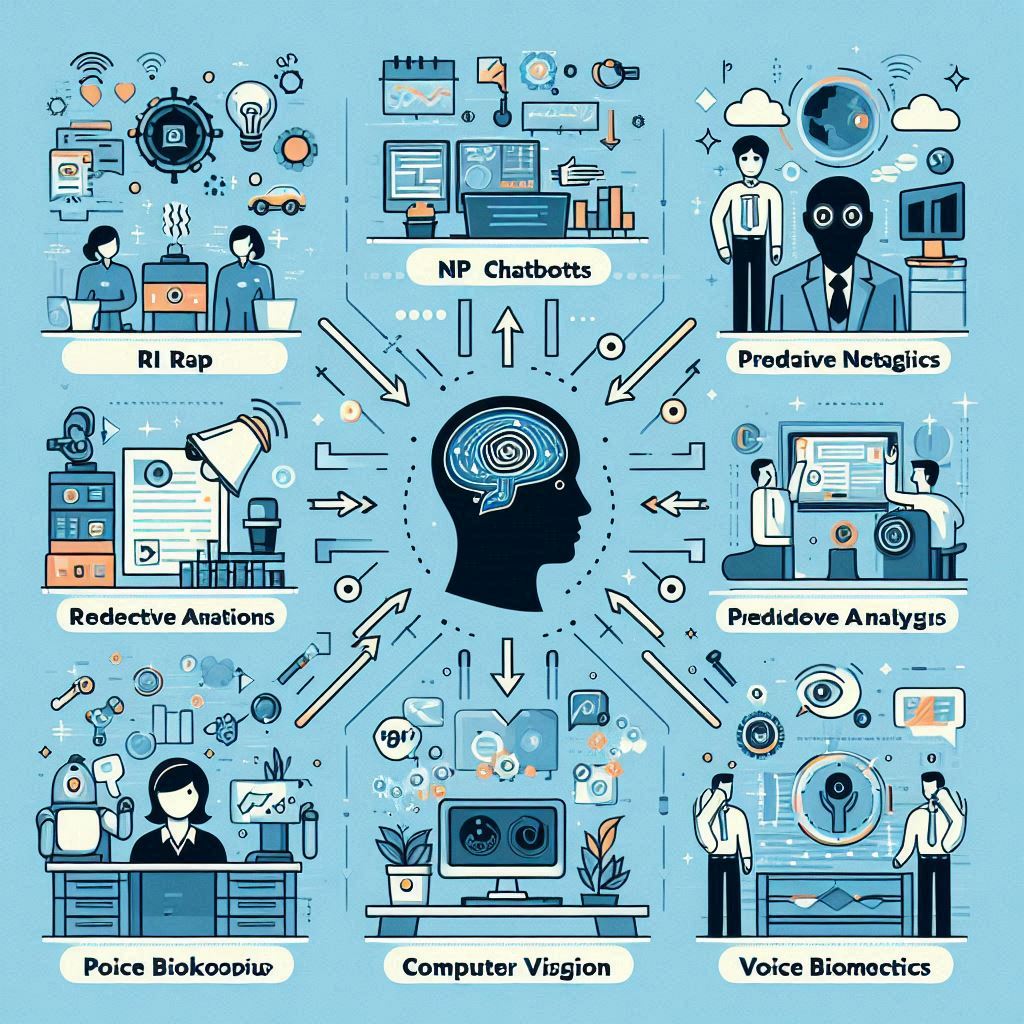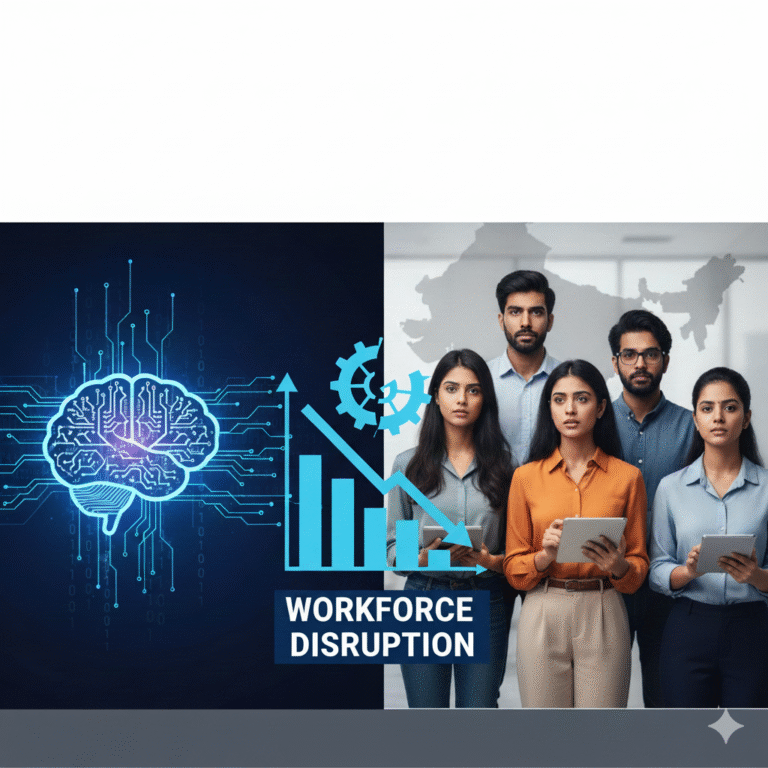Artificial Intelligence (AI) is no longer a futuristic concept limited to labs and high-tech firms—it’s rapidly reshaping workplaces across India’s diverse sectors. From automating routine tasks to enhancing decision-making with predictive insights, AI promises to boost productivity, foster innovation, and improve employee experiences. This 2,000-plus word deep dive explores how AI is changing Indian workplaces: the technologies at play, real-world applications, benefits and challenges, and the path ahead for businesses and workers alike.
The AI Landscape in India
AI Adoption Trends
- Growing Investment: Indian enterprises’ AI spend is projected to exceed $11 billion by 2025 (NASSCOM).
- Sectoral Leaders: Banking, healthcare, retail, and manufacturing are early AI adopters, while SMEs are catching up.
Drivers of AI Integration
- Competitive Pressure: Global players leveraging AI compel local firms to modernize.
- Digital India Initiative: Government programs (Digital India, National AI Strategy) provide funding and infrastructure.
- Talent Pool: India’s vast IT workforce and burgeoning AI startup ecosystem fuel innovation.
Core AI Technologies Transforming Work
Machine Learning & Predictive Analytics
- Use Case: Retailers forecast demand, optimize inventory through time-series models.
- Impact: Reduces stockouts, excess inventory by up to 30%.
Natural Language Processing (NLP)
- Use Case: Chatbots handle HR queries, IT support tickets in Hindi, English, and regional languages.
- Impact: Cuts response time from hours to seconds; frees staff for higher-value work.
Computer Vision
- Use Case: Manufacturing lines employ vision systems for quality inspection (surface defects, assembly errors).
- Impact: Raises defect detection rates above 98%, lowers recall risks.
Robotic Process Automation (RPA)
- Use Case: Banks automate loan processing—data extraction from forms, rule-based decision checks.
- Impact: Speeds approvals by 70%, reduces manual errors.
Voice & Facial Biometrics
- Use Case: Secure clock-in systems using voice recognition for attendance; facial scans for access control.
- Impact: Minimizes proxy attendance, enhances workplace security.
Sectoral Deep Dives
Manufacturing & Industry 4.0
- Smart Maintenance: AI analyzes equipment sensor data to predict failures, schedule maintenance.
- Case Study: Tata Steel’s “AI-enabled furnaces” cut unplanned downtime by 25%.
Financial Services
- Credit Scoring: ML models assess non-traditional data (mobile usage, social signals) to expand lending to unbanked.
- Fraud Detection: Real-time transaction monitoring flags anomalies with over 95% accuracy.
Healthcare & Pharmaceuticals
- Diagnostics: AI-powered image analysis assists radiologists in detecting early-stage TB, diabetic retinopathy.
- Drug Discovery: ML algorithms screen compounds, shortening lead discovery time by months.
Retail & E-Commerce
- Personalized Recommendations: Recommendation engines boost average order value by analyzing browsing and purchase history.
- Supply Chain Optimization: AI routes last-mile deliveries dynamically, cutting fuel costs and delays.
Human Resources & Talent Management
- Resume Screening: NLP automates candidate shortlisting, reducing hiring time by 50%.
- Employee Engagement: Sentiment analysis on internal communications identifies morale dips, enabling proactive interventions.
Benefits of AI in the Workplace

Productivity Gains
- Automating repetitive tasks frees employees for creative, strategic work.
- Example: RPA in back-office operations reduces transaction time from days to minutes.
Enhanced Decision-Making
- Predictive analytics inform sales forecasts, capacity planning, and financial risk assessments.
- Data-driven insights replace gut-feel decisions, improving accuracy and confidence.
Improved Employee Experience
- Chatbots offer 24/7 support for routine queries, reducing frustration.
- AI-driven learning platforms personalize upskilling paths, fostering career growth.
Cost Savings
- Preventive maintenance avoids expensive breakdowns; AI-optimized energy management slashes utility bills.
- Case: Schneider Electric’s AI energy platform cut factory power consumption by 15%.
Challenges & Considerations
Skill Gaps
- Upskilling Need: Over 60% of India’s workforce requires AI training (McKinsey).
- Solution: Public-private partnerships for AI education (e.g., Atal Innovation Mission, Coursera for Business).
Data Privacy & Ethics
- Concerns: Sensitive employee data (performance metrics, biometrics) must be protected.
- Approach: Implement robust governance frameworks—data anonymization, consent management, bias audits.
Change Management
- Resistance to Automation: Fear of job loss can breed pushback.
- Strategy: Transparent communication, reskilling programs, and redeployment pathways.
Infrastructure Constraints
- Connectivity Gaps: Rural and Tier-2 cities face bandwidth and cloud access issues.
- Solution: Leverage edge AI solutions and hybrid cloud models.
The Future of AI in Indian Workplaces
Hyper-Automation
- Convergence of RPA, AI, and low-code platforms to automate end-to-end processes.
- Example: Finance teams using AI workflows for budgeting, forecasting, and compliance.
AI-Driven Collaboration
- Virtual Assistants: Context-aware bots scheduling meetings, summarizing discussions, and tracking action items.
- Augmented Reality (AR): Remote experts guiding on-site technicians through wearable AR headsets.
Democratization of AI
- No-code/low-code AI platforms enable domain experts (not just data scientists) to build models.
- Impact: Fosters “citizen AI” and embeds intelligence into everyday tools.
Ethical and Explainable AI
- Growing emphasis on interpretability—tools that explain model decisions in human-readable form.
- Adoption of frameworks like Google’s What-If Tool, IBM’s AI Explainability 360.
Recommendations for Businesses
- Start Small, Scale Fast: Pilot AI in a high-ROI process, measure impact, then expand.
- Invest in Talent: Blend in-house training with strategic hiring of data science and AI specialists.
- Build a Data Foundation: Ensure high-quality, accessible data through governance, integration, and cleansing.
- Foster a Culture of Innovation: Encourage cross-functional AI “guilds” to share learnings and best practices.
- Prioritize Ethics and Compliance: Embed privacy-by-design and conduct regular bias audits.
Conclusion
AI stands poised to revolutionize Indian workplaces, offering unprecedented gains in efficiency, employee satisfaction, and competitive advantage. Yet, realizing this potential demands thoughtful strategy—closing skill gaps, upholding ethical standards, and fostering a culture of continuous learning. As organizations embrace AI not merely as a technology but as a driver of cultural transformation, India’s workforce will be better equipped to thrive in the digital age.
Frequently Asked Questions
1. Will AI replace jobs in India?
AI will automate routine tasks but also create new roles in data science, AI ethics, and digital transformation. Reskilling is key.
2. What skills do employees need for an AI-driven workplace?
Foundational data literacy, familiarity with AI tools, critical thinking, and adaptability to new workflows.
3. How can SMEs adopt AI with limited budgets?
Start with cloud-based, pay-as-you-go AI services and low-code platforms to minimize upfront investment.
4. Is employee data privacy at risk with AI systems?
Only if proper governance isn’t in place. Adopt encryption, anonymization, and clear consent mechanisms.
5. How do organizations measure ROI on AI projects?
Tracking KPIs like process time reduction, error rate decrease, revenue uplift, and employee satisfaction.
6. Can AI help with recruitment bias?
Yes—if models are trained on diverse, balanced datasets and regularly audited for discriminatory patterns.
7. What role does government policy play?
Initiatives like Digital India and National AI Strategy provide infrastructure, funding, and regulatory guidance.
8. How do rural businesses leverage AI amid connectivity challenges?
Edge AI devices that process data locally, syncing with the cloud when bandwidth permits.
9. What ethical frameworks are recommended?
Adopt global standards like IEEE’s Ethically Aligned Design and implement internal AI ethics committees.
10. How quickly will AI transform workplaces?
Many firms already see benefits within 6–12 months of pilot launch; widespread transformation is expected over the next 3–5 years.









+ There are no comments
Add yours